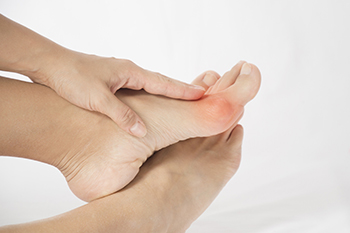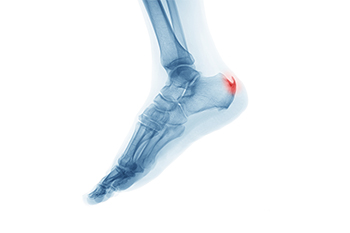Items filtered by date: November 2022
Prevention Methods to Avoid Cracked Heels

A lack of moisture in the skin of the feet may result in a condition known as cracked heels. It is often preceded by thickened skin on the heels which may become brown or yellow. Severely cracked heels are called fissures and may bleed or become infected. Cracked heels can develop for various reasons like standing on hard surfaces for most of the day and wearing shoes that have an open back. Additionally, there are medical conditions that can cause cracked heels, including dermatitis, psoriasis, and thyroid disorders. Relief may be found when the feet are soaked in warm water, followed by applying a good moisturizer. Some patients find that it may be helpful to use a pumice stone to effectively remove hardened skin. To avoid cracked heels, the best methods to implement consist of wearing closed, supportive shoes, and practicing everyday foot care. If you are afflicted with cracked heels, it is suggested that you consult with a podiatrist to determine the best treatment option for you.
Cracked heels are unsightly and can cause further damage to your shoes and feet. If you have any concerns, contact Gary Cockrell, DPM from Tennessee. Our doctor can provide the care you need to keep you pain-free and on your feet.
Cracked Heels
Cracked heels appear unappealing and can make it harder for you walk around in sandals. Aside from looking unpleasant, cracked heels can also tear stockings, socks, and wear out your shoes. There are several methods to help restore a cracked heel and prevent further damage.
How Do You Get Them?
Dry skin is the number one culprit in creating cracked heels. Many athletes, walkers, joggers, and even swimmers suffer from cracked heels. Age and skin oil production play a role to getting cracked heels as well.
Promote Healing
Over the counter medicines can help, especially for those that need instant relief or who suffer from chronic dry feet.
Wear Socks – Wearing socks with medicated creams helps lock in moisture.
Moisturizers – Applying both day and night will help alleviate dryness which causes cracking.
Pumice Stones – These exfoliate and remove dead skin, which allows for smoother moisturizer application and better absorption into the skin.
Change in Diet
Eating healthy with a well-balanced diet will give the skin a fresh and radiant look. Your body responds to the kinds of food you ingest. Omega-3 fatty acids and zinc supplements can also revitalize skin tissue.
Most importantly, seek professional help if unsure how to proceed in treating cracked heels. A podiatrist will help you with any questions or information needed.
If you have any questions, please feel free to contact our offices located in Brentwood and Madison, TN . We offer the newest diagnostic and treatment technologies for all your foot care needs.
What Does a Bunion Look Like?

There are a variety of afflictions of the feet that can negatively impact the area around the toes. Bunions are one such foot condition. A bunion is a bony bump that can develop on the side of the foot, particularly on the side of the big toe or on the side of the pinky toe. Many individuals are curious to know what a bunion looks like for good reasons because being aware of this can help you identify a bunion at an early stage. Commonly, a bunion looks like a bulge. When the bunion is located on the side of the big toe, it might look as though the foot bone juts out at an angle. In some cases of bunions, the toes might even look crowded because of the bunion. The big toe might also look like it is turned inward. Contact a podiatrist today for more information about what bunions look like.
If you are suffering from bunions, contact Gary Cockrell, DPM of Tennessee. Our doctor can provide the care you need to keep you pain-free and on your feet.
What Is a Bunion?
A bunion is formed of swollen tissue or an enlargement of boney growth, usually located at the base joint of the toe that connects to the foot. The swelling occurs due to the bones in the big toe shifting inward, which impacts the other toes of the foot. This causes the area around the base of the big toe to become inflamed and painful.
Why Do Bunions Form?
Genetics – Susceptibility to bunions are often hereditary
Stress on the feet – Poorly fitted and uncomfortable footwear that places stress on feet, such as heels, can worsen existing bunions
How Are Bunions Diagnosed?
Doctors often perform two tests – blood tests and x-rays – when trying to diagnose bunions, especially in the early stages of development. Blood tests help determine if the foot pain is being caused by something else, such as arthritis, while x-rays provide a clear picture of your bone structure to your doctor.
How Are Bunions Treated?
- Refrain from wearing heels or similar shoes that cause discomfort
- Select wider shoes that can provide more comfort and reduce pain
- Anti-inflammatory and pain management drugs
- Orthotics or foot inserts
- Surgery
If you have any questions, please feel free to contact our offices located in Brentwood and Madison, TN . We offer the newest diagnostic and treatment technologies for all your foot care needs.
When Do You Need Surgery for an Ingrown Toenail?

An ingrown toenail happens when the top corner or side of a toenail grows into the skin next to it. It is most common on the big toe. Usually, ingrown toenails occur from wearing shoes that are too tight, cutting toenails too short, or a toenail injury. They can be painful, especially if the nail is pressed on. This condition can often be treated at home by soaking the foot in warm water and dislodging the nail from the skin with a cotton swab, but sometimes medical intervention is necessary. If treating the ailment at home does not work, one repeatedly gets ingrown toenails, or one develops an infection or some other complication, surgery might be needed. Those who have diabetes, or another medical condition, are more apt to need surgery for ingrown toenails. Part or all of the affected nails may need to be removed during the process. If you have an ingrown toenail that is not resolving itself, seek the counsel of a podiatrist who can perform surgery or do whatever else is necessary to take care of the problem.
Ingrown toenails may initially present themselves as a minor discomfort, but they may progress into an infection in the skin without proper treatment. For more information about ingrown toenails, contact Gary Cockrell, DPM of Tennessee. Our doctor can provide the care you need to keep you pain-free and on your feet.
Ingrown Toenails
Ingrown toenails are caused when the corner or side of a toenail grows into the soft flesh surrounding it. They often result in redness, swelling, pain, and in some cases, infection. This condition typically affects the big toe and may recur if it is not treated properly.
Causes
- Improper toenail trimming
- Genetics
- Improper shoe fitting
- Injury from pedicures or nail picking
- Abnormal gait
- Poor hygiene
You are more likely to develop an ingrown toenail if you are obese, have diabetes, arthritis, or have any fungal infection in your nails. Additionally, people who have foot or toe deformities are at a higher risk of developing an ingrown toenail.
Symptoms
Some symptoms of ingrown toenails are redness, swelling, and pain. In rare cases, there may be a yellowish drainage coming from the nail.
Treatment
Ignoring an ingrown toenail can have serious complications. Infections of the nail border can progress to a deeper soft-tissue infection, which can then turn into a bone infection. You should always speak with your podiatrist if you suspect you have an ingrown toenail, especially if you have diabetes or poor circulation.
If you have any questions, please feel free to contact our offices located in Brentwood and Madison, TN . We offer the newest diagnostic and treatment technologies for all your foot care needs.
Reminder: When Was the Last Time...?
A Broken Foot Affects Daily Life

A broken foot can wreak havoc in daily life and cause severe pain and discomfort. It can also make everyday tasks impossible to complete. Most broken feet occur from a fall as the foot may twist in a different direction than the rest of the body. Conversely, it may also happen gradually, and this may be referred to as a stress fracture. Common symptoms that many people experience with a broken foot can consist of a bone that may protrude through the skin appearing displaced, and the foot may immediately become bruised or swollen. It is difficult to walk and prompt medical attention is often sought. A proper diagnosis consists of having an X-ray taken and this is successful in determining the severity of the fracture. A cast or protective boot may be prescribed for approximately six weeks. If you have broken your foot, it is suggested that you speak to a podiatrist who can diagnose and treat it as quickly as possible.
A broken foot requires immediate medical attention and treatment. If you need your feet checked, contact Gary Cockrell, DPM from Tennessee. Our doctor can provide the care you need to keep you pain-free and on your feet.
Broken Foot Causes, Symptoms, and Treatment
A broken foot is caused by one of the bones in the foot typically breaking when bended, crushed, or stretched beyond its natural capabilities. Usually the location of the fracture indicates how the break occurred, whether it was through an object, fall, or any other type of injury.
Common Symptoms of Broken Feet:
- Bruising
- Pain
- Redness
- Swelling
- Blue in color
- Numbness
- Cold
- Misshapen
- Cuts
- Deformities
Those that suspect they have a broken foot shoot seek urgent medical attention where a medical professional could diagnose the severity.
Treatment for broken bones varies depending on the cause, severity and location. Some will require the use of splints, casts or crutches while others could even involve surgery to repair the broken bones. Personal care includes the use of ice and keeping the foot stabilized and elevated.
If you have any questions please feel free to contact our offices located in Brentwood and Madison, TN . We offer the newest diagnostic and treatment technologies for all your foot and ankle needs.
Treatment for Bone Spurs on the Feet

A bone spur, or osteophyte, is an extra growth onto a bone. Spurs can grow on several parts of the feet, including on top of the midfoot, on the back of the heel, or on the toe. Other bone spurs grow under the heel in conjunction with plantar fasciitis. Many people live with bone spurs and feel no pain. Surgical treatment is one way of permanently dealing with painful bone spurs. With a midfoot bump, the spur is removed from both sides of the joint involved. A surgical shoe will be needed for a few weeks after, but you can bear weight right after surgery. For a spur in the back of the heel, the spur will be removed and any damage to the Achilles tendon will be repaired. A cast and crutches will be needed for a few weeks to avoid putting weight on the foot. With a spur on the toe, a small incision will be made before the filing down of the spur with a type of rasp. The site will be bandaged and a surgical shoe may be provided, but weight bearing is OK. For help with painful bone spurs, it is wise to consult with a podiatrist for the right treatment options.
Foot Pain
Foot pain can be extremely painful and debilitating. If you have a foot pain, consult with Gary Cockrell, DPM from Tennessee. Our doctor will assess your condition and provide you with quality foot and ankle treatment.
Causes
Foot pain is a very broad condition that could be caused by one or more ailments. The most common include:
- Bunions
- Hammertoes
- Plantar Fasciitis
- Bone Spurs
- Corns
- Tarsal Tunnel Syndrome
- Ingrown Toenails
- Arthritis (such as Gout, Rheumatoid, and Osteoarthritis)
- Flat Feet
- Injury (from stress fractures, broken toe, foot, ankle, Achilles tendon ruptures, and sprains)
- And more
Diagnosis
To figure out the cause of foot pain, podiatrists utilize several different methods. This can range from simple visual inspections and sensation tests to X-rays and MRI scans. Prior medical history, family medical history, and any recent physical traumatic events will all be taken into consideration for a proper diagnosis.
Treatment
Treatment depends upon the cause of the foot pain. Whether it is resting, staying off the foot, or having surgery; podiatrists have a number of treatment options available for foot pain.
If you have any questions, please feel free to contact our offices located in Brentwood and Madison, TN . We offer the newest diagnostic and treatment technologies for all your foot care needs.

